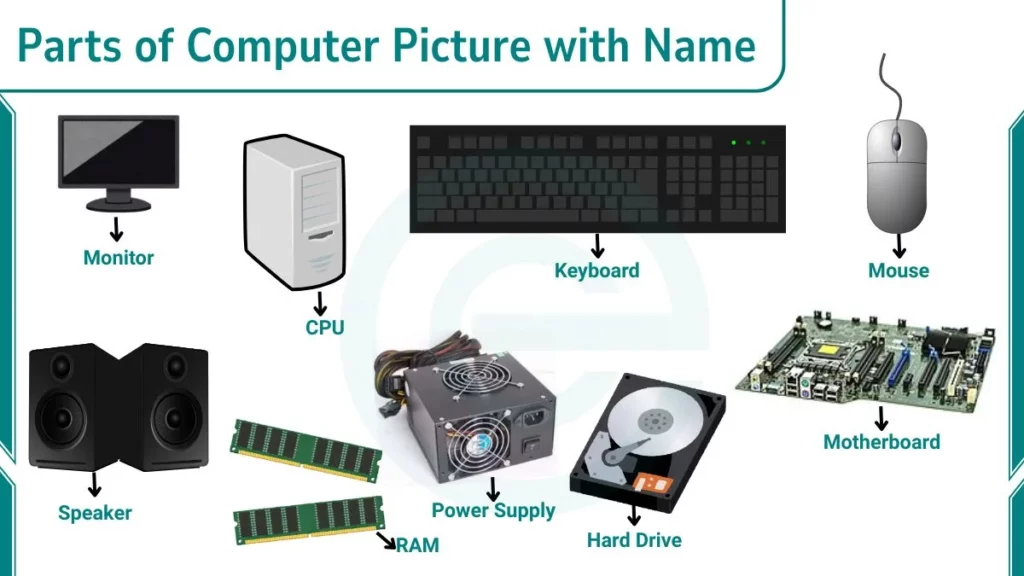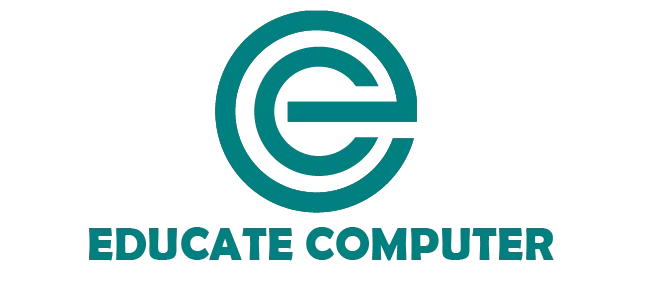Computers play a big role in our daily life. Whether you study, work, or browse the internet, your computer helps you in many ways. But have you ever thought about what makes a computer actually work? Every computer is made of different main parts that work together to process information.
In this article, we will learn about the 10 parts of a computer, how they work, and why they are important. Before understanding each part in detail, first quickly see the 10 main parts of a computer:
- Monitor
- CPU
- Keyboard
- Mouse
- Ram
- Hard Drive
- Motherboard
- Power Supply Unit (PSU)
- Printer
- Speakers
Now let’s discuss each part in detail.

10 Parts of Computer
The following are list of parts of computer name:
1. Monitor
A monitor is the screen that displays what happens inside your computer. It shows text, images, videos, and animations. Modern monitors are usually flat, lightweight, and energy-efficient. It uses technologies like LED or LCD.
Features:
- Can connect through HDMI, VGA, or DisplayPort.
- Displays high-quality visuals in HD or 4K resolution.
- Comes in different sizes (from 15 to 32 inches or more).
- Adjustable brightness and color for comfort.
Example:
When you watch a YouTube video or edit a document, the monitor displays it so you can see what you are doing.
2. CPU (Central Processing Unit)
The CPU is called the brain of the computer because it controls all processes and operations. It performs calculations, executes commands, and manages data flow. It has three main units:
- ALU (Arithmetic Logic Unit)
- CU (Control Unit)
- Registers
Features:
- High-speed data processing.
- Handles multiple instructions per second.
- Determines computer’s overall performance.
- Works with other components like RAM and motherboard.
Example:
When you open a game or run software like MS Word, the CPU processes the instructions and makes everything work smoothly.
3. Keyboard
A keyboard is an input device used to type letters, numbers, and symbols into a computer. It helps you enter commands and create documents easily.
Features:
- Usually has 104 or more keys.
- Includes special keys like Enter, Shift, Ctrl, and Alt.
- Comes in wired or wireless types.
- Some keyboards have backlights for use in low light.
Example:
When you type an email or write code, you use the keyboard to input the information into the computer.
4. Mouse
A mouse is another input device that lets you control the cursor on the screen. You can click, drag, and scroll to interact with the computer easily.
Features:
- Has left, right, and scroll buttons.
- Uses optical or laser sensors for accuracy.
- Can be wired or wireless (Bluetooth).
- Compact and easy to use.
Example:
When you click on a folder to open it or drag a file to the recycle bin, you are using the mouse to give commands.
5. RAM (Random Access Memory)
RAM is the temporary or short-term memory of the computer. It stores data that is actively being used by the CPU. When the computer is turned off, data in RAM is erased.
Features:
- Makes computer multitasking faster.
- Measured in GB (like 4GB, 8GB, 16GB).
- Volatile. Data is lost when power is off.
- Increases performance in gaming and software use.
Example:
When you play a game or open multiple browser tabs, RAM keeps all those programs running smoothly at the same time.
6. Hard Drive / SSD
The hard drive or SSD (Solid State Drive) stores your data permanently including files, videos, apps, and system software.
Features:
- Long-term data storage.
- SSDs are faster and quieter than HDDs.
- HDDs are cheaper and store more data.
- Data remains safe even when the computer is off.
Example:
When you save a photo or download a movie, it gets stored in your hard drive or SSD for future access.
7. Motherboard
The motherboard is the main circuit board that connects all computer parts. It allows communication between the CPU, RAM, storage, and other components.
Features:
- Holds sockets and ports for other hardware.
- Includes BIOS to start the computer.
- Supports USB, audio, and display ports.
- Designed for specific CPUs (Intel or AMD).
Example:
When you press the power button and the system starts booting, the motherboard sends signals between parts to start the operating system.
8. Power Supply Unit (PSU)
The power supply unit provides electricity to the computer. It converts power from your wall outlet (AC) into the type your computer parts need (DC).
Features:
- Supplies stable power to prevent damage.
- Has a cooling fan to avoid overheating.
- Rated by wattage (like 500W, 650W).
- Includes safety features like surge protection.
Example:
When you turn on your computer, the PSU supplies power to the motherboard, CPU, and all other components to start the system.
9. Printer
A printer is an output device that produces physical copies of digital documents or images. It’s commonly used in schools and offices.
Features:
- Prints in color or black and white.
- Can connect through USB or Wi-Fi.
- Uses ink (Inkjet) or toner (Laser).
- Some models also scan and copy.
Example:
When you print your homework assignment or exam paper, the printer converts your digital file into a paper copy.
10. Speakers
Speakers are output devices that produce sound. They allow you to listen to music, videos, and online classes.
Features:
- Converts digital signals into sound waves.
- Can be built-in or external.
- Available in stereo or surround sound systems.
- Connects via USB, Bluetooth, or audio jack.
Example:
When you watch a video lecture or listen to a song, the speakers produce sound so you can hear it clearly.
FAQs
What are the 5 basic parts of a computer?
The five basic parts are the monitor, CPU, keyboard, mouse, and storage device.
Is the CPU and motherboard the same?
No, the CPU is the brain, and the motherboard connects all other parts.
What is the most important part of a computer?
The CPU is the most important part because it controls all operations.
